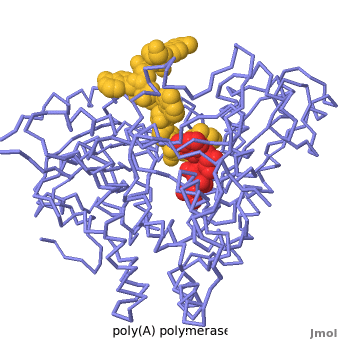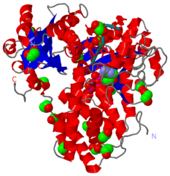Function
Poly(A) Polymerase (polynucleotide adenylytransferase, EC 2.7.7.19) is the enzyme responsible for adding a polyadenine tail to the 3' end of a nascent pre-mRNA transcript. Its substrates are ATP and RNA. The poly(A) tail that poly-A polymerase adds to the 3' end of the pre-mRNA transcript is important for nuclear export, translation and stability of the mRNA.
- Star-PAP selects mRNA targets for polyadenylation[1].
Determinants of ATP Recognition
Poly(A) Polymerase binds specifically to ATP and adds it at the end of a messenger RNA chain. This structure contains an oligo(A) polynucleotide with five nucleotides, an ATP molecule, and a magnesium ion. The enzyme is an inactive mutant with the catalytic aspartate 154 changed to alanine. Poly(A) polymerase normally has a second magnesium ion, but that second magnesium ion is absent from this structure due to the inactivating mutation D154A. In the , the enzyme is in blue backbone representation, the RNA chain is in yellow, the ATP is in red, the magnesium is in green, and ALA154 is in magenta. Several mechanisms are used to achieve the specificity for ATP. The magnesium is coordinated by , and the magnesium coordinates with the phosphates of ATP, positioning the nucleotide in the active site. The adenine base is sandwiched between the . Surprisingly, there are very few contacts with the hydrogen-bonding groups in the adenine base. may form a hydrogen bond to adenine in the active enzyme, but the distance is a bit too long in this mutant structure. Instead of forming specific hydrogen bonds with the enzyme, most of the hydrogen-bonding groups in the base, sugar and phosphate interact with a shell of . Discrimination between ATP and GTP is achieved through a close steric contact between the . Guanine bases have an extra amino group at this position that would be too bulky to fit against these amino acids.
This section complements the article on Poly(A) Polymerase in the
Molecule of the Month Series. See also Teaching Scenes, Tutorials, and Educators' Pages.
3D structures of poly(A) polymerase
Poly(A) polymerase 3D structures


